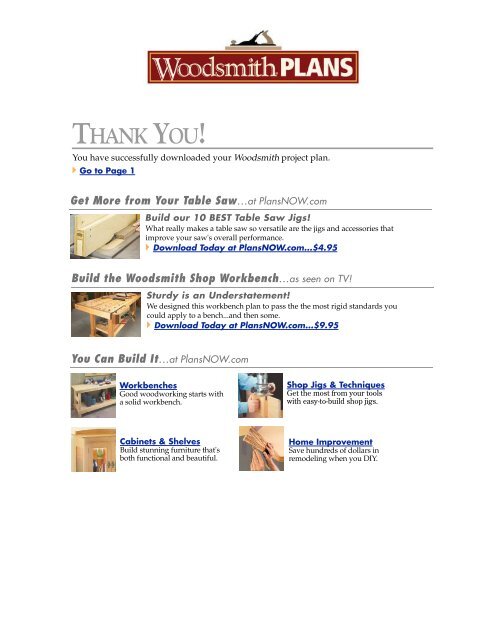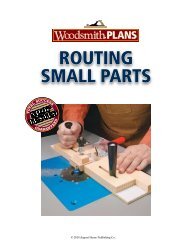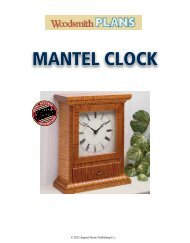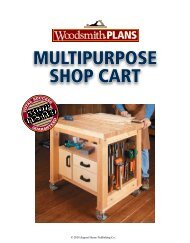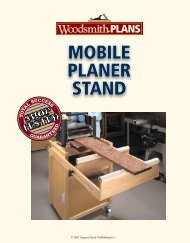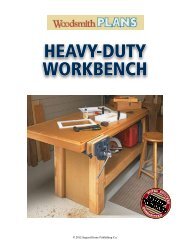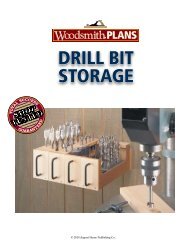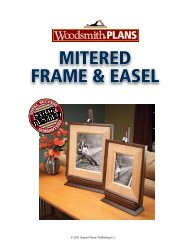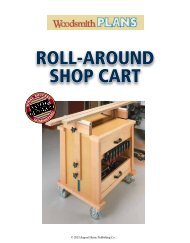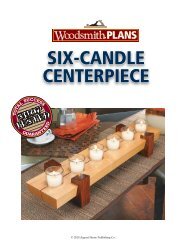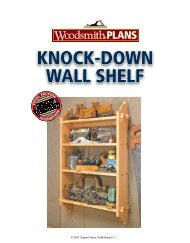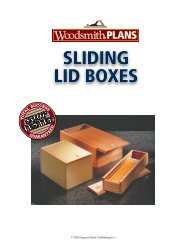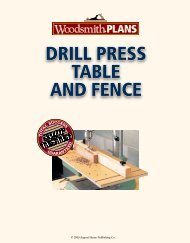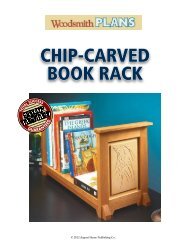You also want an ePaper? Increase the reach of your titles
YUMPU automatically turns print PDFs into web optimized ePapers that Google loves.
Thank You!<br />
You have successfully downloaded your <strong>Woodsmith</strong> project plan.<br />
4Go to Page 1<br />
Get More from Your Table Saw...at PlansNOW.com<br />
Build our 10 BEST Table Saw Jigs!<br />
What really makes a table saw so versatile are the jigs and accessories that<br />
improve your saw's overall performance.<br />
4Download Today at PlansNOW.com...$4.95<br />
Build the <strong>Woodsmith</strong> <strong>Shop</strong> Workbench...as seen on TV!<br />
Sturdy is an Understatement!<br />
We designed this workbench plan to pass the the most rigid standards you<br />
could apply to a bench...and then some.<br />
4Download Today at PlansNOW.com...$9.95<br />
You Can Build It...at PlansNOW.com<br />
Workbenches<br />
Good woodworking starts with<br />
a solid workbench.<br />
Cabinets & Shelves<br />
Build stunning furniture that's<br />
both functional and beautiful.<br />
<strong>Shop</strong> Jigs & Techniques<br />
Get the most from your tools<br />
with easy-to-build shop jigs.<br />
Home Improvement<br />
Save hundreds of dollars in<br />
remodeling when you DIY.
MORTISE<br />
AND TENON<br />
© 2007 August Home Publishing Co.
WoodWorking<br />
technique<br />
<strong>Mortise</strong> & tenon<br />
There are several good ways to make a mortise and tenon joint.<br />
The trick is determining which one is best for the task at hand.<br />
I’ve always thought of mortise and<br />
tenons as the “bread and butter”<br />
of woodworking joints. Although<br />
they’re not as showy as dovetails or<br />
box joints, they’re often the backbone<br />
of a woodworking project.<br />
And the main reason for this is their<br />
incredible strength.<br />
In a well-constructed joint, the<br />
tenon slips into the mortise like a<br />
sword in a sheath. This does two<br />
things. First, the close fit locks the<br />
two workpieces together to create a<br />
strong mechanical joint. In addition,<br />
there’s a large glue surface where<br />
the cheeks of the tenon contact the<br />
sides of the mortise, so it provides<br />
a strong glue joint as well.<br />
Maybe this explains why mortise<br />
and tenon joints have been around<br />
for so long, and why you’ll find<br />
them just about everywhere, see<br />
the examples below.<br />
MULTIPLE METHODS. You might think<br />
there’s a single, proven method for<br />
making such a universal joint. This<br />
may have been the case back when<br />
mortise and tenon joints were made<br />
by hand. But with the power tools<br />
available today, there are several<br />
{ Frames. <strong>Mortise</strong> and<br />
tenon joints create strong<br />
frames that resist twisting.<br />
ways of creating both the mortise and<br />
the tenon. The trick is deciding on<br />
the best method in each situation.<br />
In the <strong>Woodsmith</strong> shop, we use several<br />
different methods on a regular<br />
basis. But the technique we choose<br />
depends on the size and number of<br />
joints, the length of the workpieces,<br />
and the tools we have available.<br />
So I thought it might be worthwhile<br />
to take a look at some of the various<br />
{ Slats. A row of mortises<br />
in a rail can be used to<br />
hold a series of slats.<br />
techniques for creating a mortise<br />
and tenon joint and explain how to go<br />
about selecting the best method.<br />
Regardless of the method, I almost<br />
always follow the same sequence<br />
when making a mortise and tenon<br />
joint. I make the mortise first and<br />
then cut the tenon to fit. The reason<br />
is simple — it’s a lot easier to pare<br />
a little material off a tenon than it is<br />
to enlarge a mortise.<br />
{ Leg & Rail. A through<br />
mortise is both decorative<br />
and functional.<br />
1 www.<strong>Woodsmith</strong>.com © 2007 August Home Publishing Co. All Rights Reserved.
The <strong>Mortise</strong><br />
There’s more to making a mortise<br />
than simply hacking out an opening<br />
in a workpiece. Anytime I’m making a<br />
mortise, I’m concerned with a couple<br />
of things — speed and accuracy.<br />
I want a quick way to remove the<br />
material from the workpiece to create<br />
the mortise. But I also want to make<br />
sure the ends of the mortise are<br />
square with the sides, and the sides<br />
are square with the face of the workpiece.<br />
This is important if you want to<br />
get a good fit with the tenon.<br />
DRILL PRESS METHOD<br />
One of the simplest methods available<br />
that satisfies both of these requirements<br />
is to use a drill press to remove<br />
most of the waste of the mortise (Fig.<br />
1). Using a Forstner or brad point bit,<br />
I drill a series of overlapping holes<br />
to create a rough opening. Then I<br />
square up the ends and sides of the<br />
mortise with a chisel, (Fig. 2).<br />
<strong>Shop</strong> Note: If your workpiece is<br />
too long or heavy to place on a drill<br />
press, try using a handheld drill with<br />
a dowel jig to guide the drill bit.<br />
There are a couple of things I<br />
like about this method (which is<br />
probably why I use it more than<br />
any other). First, it doesn’t require<br />
any lengthy setup of equipment.<br />
The width of the mortise is determined<br />
by the diameter of the drill<br />
bit and the depth by the depth stop<br />
on the drill press. All you need is<br />
a simple fence clamped to the drill<br />
press table to establish the position<br />
of the mortise in the workpiece.<br />
Second, it allows me to see my work<br />
at all times. As I’m drilling the row of<br />
3<br />
1 2<br />
holes, it’s easy to tell if I’m wandering<br />
outside of my layout lines.<br />
As useful as it is, drilling a series<br />
of holes and cleaning up the sides of<br />
each mortise with a chisel can be a<br />
time-consuming task, particularly if<br />
you have a lot of mortises to make.<br />
For some projects, it makes more<br />
sense to use a different technique.<br />
ROUTER METHOD<br />
Sometimes I need to make a series<br />
of identical mortises in a workpiece.<br />
For example, if I’m building a project<br />
with a row of slats or spindles, I use a<br />
router to cut the mortises.<br />
Using an edge guide or a shopmade<br />
jig, it’s possible to rout a series<br />
of mortises in less time than it would<br />
take to drill them on a drill press, see<br />
Fig. 3. It’s simply a matter of setting<br />
up the edge guide and routing a slot<br />
for each mortise.<br />
<strong>Shop</strong> Note: I don’t like to take<br />
more than a 1/4"-deep cut on any single<br />
pass. If I need to make a mortise<br />
deeper than this, I’ll take multiple<br />
2 www.<strong>Woodsmith</strong>.com © 2007 August Home Publishing Co. All Rights Reserved.<br />
4<br />
passes, lowering the bit in between.<br />
And to prevent the slot from filling<br />
up with shavings, I also prefer to<br />
use spiral end mill bits rather than<br />
ordinary straight bits for routing<br />
mortises, see photo at right.<br />
Aside from the speed, the nice<br />
thing about a mortise that’s made<br />
with a router is the fact that it has<br />
perfectly smooth sides. The only<br />
handtool work that’s required is to<br />
square up the ends of the mortise<br />
with a chisel, see Fig. 4.<br />
DRAWBACKS. There are a couple of<br />
downsides to using a router for<br />
making mortises, though. First,<br />
although it’s possible to get by with<br />
a standard router, routing mortises<br />
is really a job that calls for a more<br />
expensive plunge router.<br />
But more importantly, I always<br />
feel like I’m sacrificing some control<br />
when I use a router. Since the router<br />
cuts a mortise so quickly (and you<br />
don’t have a clear view of the mortise<br />
while you’re routing), it only takes a<br />
split second to make a mistake.<br />
{ The deep flutes<br />
of a spiral end<br />
mill bit are<br />
designed to pull<br />
the shavings<br />
out of a mortise<br />
quickly.
<strong>Mortise</strong>rs<br />
Whether you use a drill press or a<br />
router to make mortises, either way<br />
you still have to square up the ends<br />
of the mortise by hand. But there’s<br />
a tool that will drill out the waste of<br />
the mortise and neatly square up<br />
the ends all in one step — the hollow<br />
chisel mortising machine, see<br />
first photo at right.<br />
SQUARE HOLES. Although it may<br />
sound impossible, a mor tising<br />
machine will actually drill a<br />
square hole. The secret behind<br />
these machines lies in the hollow<br />
chisel bits they use, which consist of<br />
a drill bit surrounded by a square,<br />
thin-walled chisel.<br />
As the bit is lowered into the<br />
wood, it removes most of the waste<br />
while the chisel squares up the sides<br />
at the same time. By drilling a series<br />
of overlapping square holes, you can<br />
make a mortise of just about any<br />
The <strong>Tenon</strong><br />
Once the mortise is complete, the<br />
next step is to cut a tenon to fit.<br />
Side<br />
shoulder Here again, you have a choice of<br />
several methods. But the goal is<br />
the same. You want to wind<br />
up with a tenon that has<br />
square shoulders and<br />
Cheek<br />
flat cheeks, see photo<br />
at left.<br />
Although tenons<br />
can be made with a number<br />
of different tools, I gen-<br />
Edge shoulder erally prefer to use a table saw<br />
because of its speed and accuracy.<br />
DADO BLADE METHOD<br />
For most tenons, I install a dado<br />
blade in my table saw and remove the<br />
waste from the cheeks of the tenon<br />
by making multiple passes. I use<br />
{ Mortising Machine. Hollow chisels<br />
drill out the mortise and square<br />
up the ends all at once.<br />
length or width you need.<br />
Hollow chisel mortising machines<br />
work great, but their biggest drawback<br />
is their cost — about $250 or<br />
more for most models.<br />
MORTISING ATTACHMENT. A less expensive<br />
alternative is a special mortising<br />
attachment that clamps around<br />
the quill of your drill press. It<br />
works in much the same way as<br />
the rip fence as a stop to determine<br />
the length of the tenon and an auxiliary<br />
fence attached to the miter gauge<br />
to back up the cut (Figs. 1 and 1a).<br />
Then after cutting the tenon, I slide<br />
the workpiece back and forth over<br />
the blade to clean up any saw marks<br />
left behind by the blade, see Fig. 2.<br />
At first glance, you might think this<br />
method violates one of the cardinal<br />
rules of woodworking — never<br />
use the miter gauge and rip fence<br />
together. (The reason for this is that<br />
the cut-off piece can get trapped<br />
between the blade and the fence and<br />
kick back.) But when you’re cutting<br />
a tenon with a dado blade, you’re not<br />
making a through cut. So there isn’t<br />
any cut-off piece to worry about.<br />
I prefer this method for a couple<br />
1 a. 2<br />
{ Mortising Attachment. Mounted<br />
on a drill press, this attachment<br />
works like a mortising machine.<br />
a dedicated machine and uses the<br />
same hollow chisel mortising bits,<br />
see right photo above. (Mortising<br />
attachments sell for about $70,<br />
including the hollow chisel bits.)<br />
The only problem with this type<br />
of attachment is that you have to<br />
take it on and off your drill press<br />
in order to go back and forth from<br />
mortising to regular drilling.<br />
of reasons. First, the dado blade<br />
removes a wide swath of material<br />
with each pass. So it’s a simple matter<br />
to cut even a long tenon quickly.<br />
But more importantly, I find it easy<br />
to “fine tune” the fit of the tenon by<br />
making some quick adjustments. If<br />
the tenon is too thick, I simply raise<br />
the dado blade a hair. If the tenon is<br />
too short, I just move my rip fence<br />
away from the blade.<br />
TENON JIG<br />
The dado blade method works well<br />
in most cases, but it does have one<br />
drawback. The dado blade has a<br />
tendency to leave ridges on the<br />
face of the cheeks. If you’re cutting<br />
a through tenon or an open<br />
mortise and tenon (where part of<br />
3 www.<strong>Woodsmith</strong>.com © 2007 August Home Publishing Co. All Rights Reserved.
the tenon will be exposed), you<br />
want all the tenons to have smoothfaced<br />
cheeks. That’s where a tenon<br />
jig comes in handy.<br />
A tenon jig (you can buy a commercial<br />
jig or make your own) allows<br />
you to cut each cheek of a tenon in<br />
just two passes, using a single blade.<br />
This eliminates the ridges that most<br />
dado blades leave behind.<br />
To start, you simply raise the<br />
blade slightly to make the shoulder<br />
cuts, as shown in Fig 3. Then, riding<br />
in the miter gauge slot or straddling<br />
the rip fence, the tenon jig holds a<br />
workpiece upright so you can cut<br />
each cheek, see Fig. 4.<br />
Although this method gives you a<br />
{ For cutting stub tenons quickly<br />
and cleanly, I like to use a router<br />
table and a straight bit.<br />
No matter what method you<br />
use for making a mortise and<br />
tenon joint, there’s still a good<br />
chance that you will have to<br />
do some “fine tuning” to get a<br />
perfect-fitting joint.<br />
LOOSE FIT. One of the most common<br />
problems encountered in<br />
mortise and tenon joinery is a gap<br />
between the shoulder of the tenon<br />
and the mortised workpiece. This<br />
is caused by a shoulder that isn’t<br />
perfectly square or cut cleanly.<br />
To avoid this problem, I like<br />
to undercut the shoulders of<br />
the tenon slightly with a chisel.<br />
This pulls the tenoned workpiece<br />
up tight to the mating<br />
workpiece when the joint is<br />
3 4<br />
tenon with nice, smooth cheeks, there<br />
are a couple of reasons I don’t use it<br />
for all my tenons. For one, it doesn’t<br />
work well with long pieces, since it’s<br />
necessary to stand the workpiece on<br />
end while using the jig.<br />
Second, there’s no way to cut edge<br />
shoulders on a workpiece with a tenon<br />
jig. So if you’re making a tenon with<br />
edge shoulders, you have to come<br />
back and nibble away the waste with<br />
the saw blade, see Fig. 5.<br />
ROUTER<br />
There’s one other method I use<br />
to make tenons that’s worth mentioning.<br />
A router table and a router<br />
equipped with a straight bit is a<br />
great way to cut tenons on small<br />
workpieces, see drawing at left.<br />
A fence controls the length of the<br />
tenon and a miter gauge helps guide<br />
FITTING A MORTISE AND TENON JOINT<br />
assembled, see left photo below.<br />
STEPPED SHOULDERS. A common<br />
problem when cutting a fourshouldered<br />
tenon is stepped<br />
shoulders. But instead of trying<br />
to get all four shoulders flush<br />
{ Perfect Fit. To get a tight jointline,<br />
undercut the shoulders of<br />
the tenon with a chisel.<br />
4 www.<strong>Woodsmith</strong>.com © 2007 August Home Publishing Co. All Rights Reserved.<br />
5<br />
the workpiece past the router bit.<br />
A router table combines the best<br />
of both worlds — the speed and control<br />
of the dado blade method and<br />
the smooth results you get when<br />
using a tenon jig. But it works best<br />
with short, shallow tenons that can<br />
be cut on a single pass (like stub<br />
tenons for a door or for tenons on<br />
the ends of small spindles). W<br />
when cutting them on the table<br />
saw, I leave the edge shoulders<br />
intentionally high. Then I come<br />
back with a chisel and pare them<br />
flush with the side shoulders, see<br />
right photo below.<br />
{ Stepped Shoulders. Cut<br />
shoulders on edges of tenon<br />
slightly proud, then trim flush.


